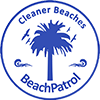
Safety first
Enjoy a safe and healthy time on the beach or your street community. We are committed to ensuring the safety of our volunteers.


BeachPatrol's vision is for everyone who uses beaches, parks and other public spaces to enjoy a clean and safe environment, and to ensure the safety of our volunteers while removing litter. Our activities are aimed at having fun and making a positive contribution - it is also important to be aware of potential hazards. Volunteers should report any hazards or incidents to their BeachPatrol or Love Our Street leader. Enjoy a safe and happy cleaning time on the beach or in your community!
